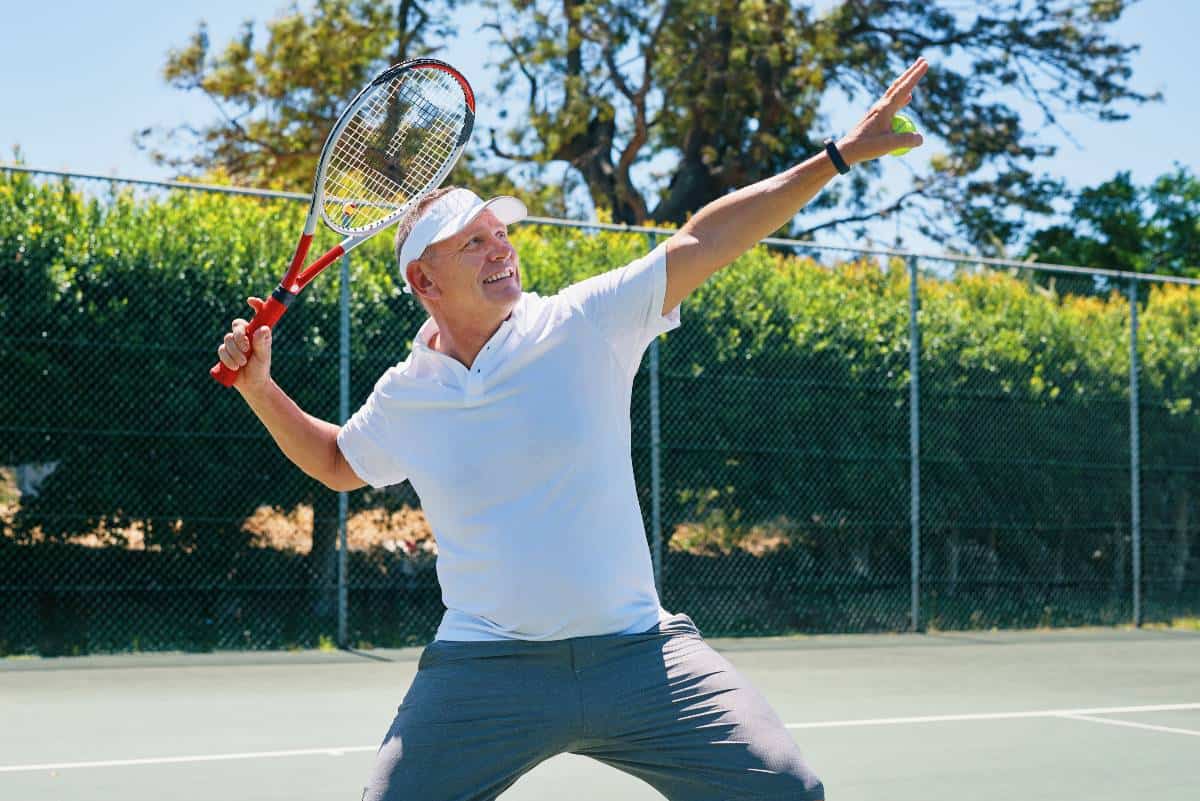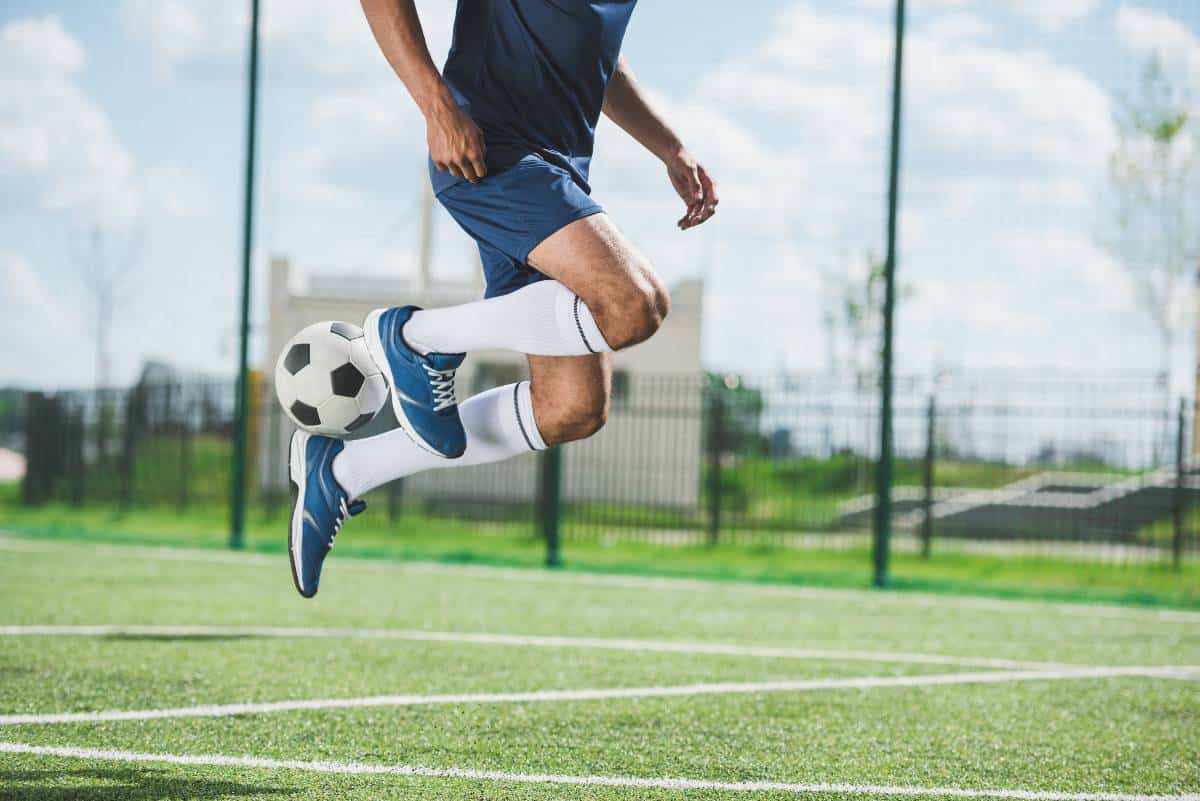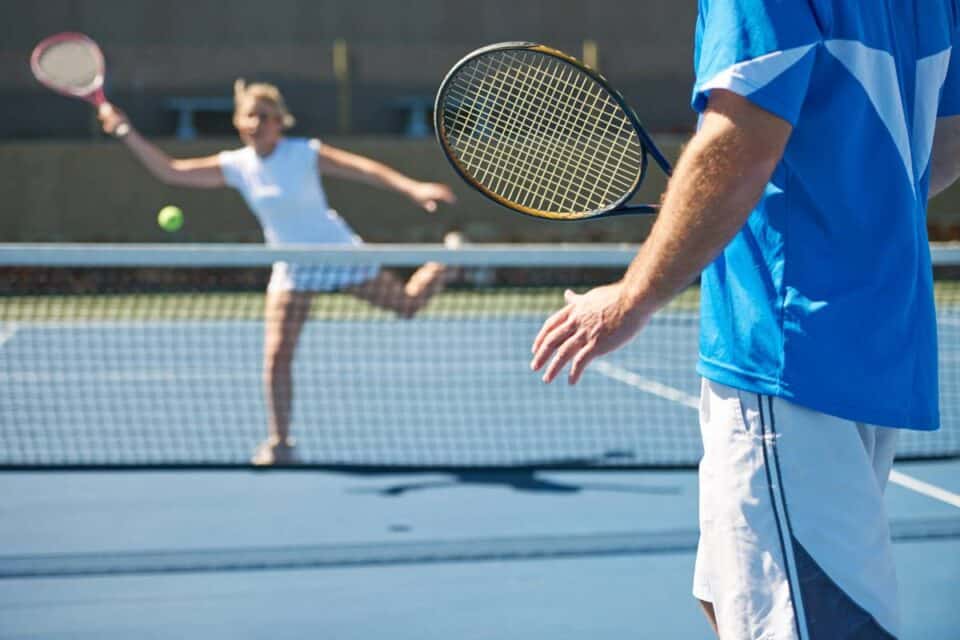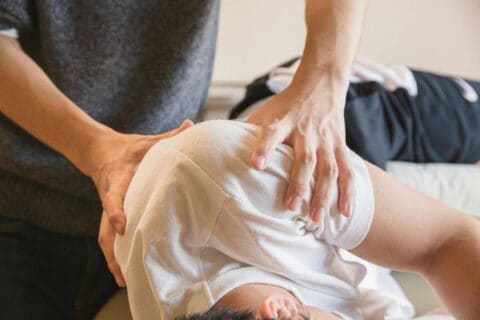As a certified sports chiropractor serving patients for some time, I’ve seen my fair share of athletes limping, hobbling, or being carried into my office. Whether you’re a weekend warrior or a professional athlete, sports injuries can sideline you faster than you can say “Ouch.” Chiropractic care offers a powerful approach to treating and preventing sports injuries.
Key Takeaways
- We utilize specialized techniques to effectively treat common athletic issues, from concussions to knee injuries
- Experience cutting-edge solutions like SpineMed spinal decompression and Summus Class IV Laser Therapy, providing relief where other treatments have failed
- We offer comprehensive, chiropractic care tailored specifically for athletes and sports injuries
Table of Contents
- Understanding Chiropractic Care for Sports Injuries
- The Chiropractic Advantage in Sports Medicine
- Top Sports Injuries Treated by Chiropractors
- Chiropractic Techniques for Sports Injury Treatment
- Beyond Traditional Chiropractic: Advanced Solutions for Athletes
- Integrating Chiropractic Care with Sports Training
- Nutrition and Supplementation Guidance
- Prevention Strategies and Long-Term Care
- Case Studies: Success Stories in Sports Chiropractic
- Choosing the Right Sports Injury Chiropractor
- FAQs
- Conclusion
Understanding Chiropractic Care for Sports Injuries
Before we jump into the nitty-gritty of specific injuries, let’s talk about why chiropractic care is such a game-changer in the world of sports medicine. As a chiropractor, my approach is all about treating the root cause of your pain, not just masking symptoms with medication.
Chiropractic treatment is based on the principle that your body has an innate ability to heal itself. My job is to help remove any interference in your body’s natural healing processes, primarily by focusing on the musculoskeletal system and its relationship to your nervous system.
The benefits of this drug-free approach are numerous:
- Reduced risk of side effects associated with pain medications
- Improved overall body function, not just symptom relief
- Enhanced athletic performance through better biomechanics
- Long-term prevention of future injuries
Experience the BodyFix Difference
Experience the difference that patient-centric, whole-body chiropractic care can make. Discover how The BodyFix’s unique approach addresses not just your pain, but your overall wellness for lasting results.
The Chiropractic Advantage in Sports Medicine
Now, you might be wondering, what makes a sports chiropractor different from other healthcare providers?” Great question! As a chiropractor specializing in sports injuries, I’ve undergone extensive training specifically tailored to the unique needs of athletes.
This specialized knowledge allows me to:
- Quickly identify the root cause of sports-related injuries
- Develop personalized treatment plans that consider an athlete’s specific sport and position
- Implement cutting-edge techniques designed to get athletes back in the game faster
Plus, as a sports chiropractor, I take a whole-body wellness perspective assessing the body through motion. This means we’re not just treating your injured knee or shoulder; we’re looking at how that injury affects your entire body and working to bring everything back into balance. And to be quite honest, regular folks have these same injuries. The “sport” title just gives us an extra aspect on how to treat certain diagnostic issues.
Top Sports Injuries Treated by Chiropractors
Alright, let’s dive deeper into the common sports injuries.
1. Concussions
Obviously we are not treating the brain here. These types of injuries cause compensations like neck whiplash which can cause musculature tightness and spinal restrictions. Concussions are more than just a bump on the head. As a chiropractor, I play a crucial role in concussion management. While I can’t reverse the initial impact, I can help manage symptoms and support your brain’s healing process through gentle cervical spine adjustments and other techniques.
Concussions can cause a range of symptoms, including headaches, dizziness, confusion, and balance problems. My approach involves careful assessment of cervical spine function, as neck injuries often accompany concussions.
2. Knee Injuries or Knee Problems
The knee is a complex hinge joint that takes a beating in many sports. From minor sprains to more severe ligament tears like ACL injuries, knee injuries are a common sight in my office. Chiropractic adjustments can help restore proper alignment and function to the knee joint, reducing pain and improving stability.1 And adjustments are a small percentage of the treatment process when dealing with knees. Soft tissue work as well as exercise rehab play a crucial role in overall longevity and stability.
But it’s not just about the knee itself. We also assess the entire kinetic chain – from the foot and ankle up through the hip and lower back. Often, knee pain can be caused or exacerbated by issues elsewhere in the body.
3. Calf and Hamstring Pain
Leg muscle strains can sideline athletes unexpectedly. My approach combines soft tissue therapy, adjustments, and targeted exercises to restore function and prevent recurrence. If the injury is severely acutely inflamed then we utilize Class IV Laser Therapy.
For these injuries, I employ techniques like the Active Release Technique (ART) to address scar tissue and the Graston Technique to enhance blood flow. A thorough analysis of gait and running mechanics helps identify contributing factors. We get a ton of “Tennis Leg” diagnoses in our office. It happens when the posterior motion chain of our bodies is super tight and restricted. This chain is assessed by looking at your lower back all the way down to your plantar fascia.
4. Lower Back Pain and Injuries
Whether you’re a golfer with a twisted swing or a runner pounding the pavement, lower back pain can put a real damper on your athletic pursuits. Spinal adjustments and core strengthening exercises are your best friends here. For more severe disc herniation cases, our Spine Med Decompression table is your best treatment compared to chiropractic adjustments.
Lower back pain in athletes often stems from a combination of factors – poor posture, muscle imbalances, and repetitive stress. I use spinal adjustments to restore proper alignment and movement to the vertebral facet joints.
I also focus on strengthening the core muscles and the glutes that support the spine, improving flexibility in tight muscles like the hip flexors and hamstrings, and teaching proper body mechanics for your specific sport. This comprehensive approach not only relieves pain but helps prevent future back issues.
5. Shoulder Pain and Rotator Cuff Injuries
From swimmers to baseball pitchers, shoulder issues are a dime a dozen in the sports world. Rotator cuff injuries can be particularly nasty, but with the right combination of adjustments, exercises, and soft tissue work, we can get your shoulder back in the game.
The shoulder is a complex joint that requires a delicate balance of stability and mobility. When treating shoulder injuries, I start with a thorough assessment of not just the shoulder, but also the neck, upper back, and even the elbow. Posture is the key here. Every time I see bad posture I usually see a shoulder impingement developing or already there.
Often, problems in these areas can contribute to shoulder pain. I use adjustments or joint mobilizations to improve joint mobility, soft tissue techniques to address muscle imbalances, and specific exercises to strengthen the rotator cuff and scapular stabilizers. Sometimes shoulder joints respond better to repetitive mobilizations compared to one “pop” to the joint. It’s a highly mobile joint that lacks stability.
6. Neck Pain
Neck pain isn’t just for office workers – athletes can suffer from it too, especially in contact sports. Gentle cervical spine adjustments and targeted therapies can work wonders for relieving neck pain and improving range of motion.
When treating neck pain in athletes, I consider both acute injuries (like whiplash from a tackle) and chronic issues from repetitive stress. Cervical spine adjustments can help restore proper alignment and movement to the neck vertebrae.
Again, postural assessment and correction are crucial, as poor posture during training or competition can lead to chronic neck issues.
7. Groin Strain
Ouch! Groin strains are as uncomfortable as they sound. But fear not – through the Active Release Technique and other specialized techniques, we can help those groin muscles heal and get you back to your lateral movements.
Groin strains are common in sports that involve sudden changes of direction, like soccer or hockey. When treating groin strains, I start by assessing not just the groin muscles, but also the hip joint, lower back, and even the opposite side of the body. Often, imbalances or restrictions in these areas can contribute to groin strains.
8. Golfer’s Elbow or Tennis Elbow
Despite their names, you don’t have to play golf or tennis to suffer from these overuse injuries. Joint manipulation and specific exercises can help alleviate pain and restore function to your elbow.
Both golfer’s elbow (medial epicondylitis) and tennis elbow (lateral epicondylitis) are forms of tendinopathy caused by repetitive stress. In addition to joint manipulation of the elbow, I will often adjust the wrist, shoulder, and even the neck, as dysfunction in these areas can contribute to elbow pain.
Soft tissue techniques like Graston or A.R.T can help break up scar tissue in the affected tendons and help them slide better in their sheaths. I also use kinesiology taping to support the area and reduce strain during healing.
A crucial part of treatment is addressing the underlying cause – this might involve analyzing and correcting flaws in your golf swing or tennis serve, or making ergonomic changes if the issue is related to work activities.
9. Achilles Tendon Issues and Pain
The Achilles tendon might be named after a Greek hero, but it can certainly be a weakness for many athletes. Chiropractic care for Achilles tendon issues focuses on improving overall foot and ankle biomechanics to reduce strain on this crucial tendon.
Achilles tendinopathy is often related to overuse, but can also stem from biomechanical issues in the foot, ankle, or even higher up the kinetic chain. I start by assessing overall lower limb biomechanics, including gait analysis.
Ankles are usually restricted in dorsiflexion which is moving the ankle upwards toward your head. Adjustments to the foot and ankle can help improve joint mobility and reduce stress on the Achilles tendon. Soft tissue techniques can address any adhesions or scar tissue in the tendon itself. The Soleus muscle is an under-examined muscle that tends to get tight and lock up the Achilles tendon.
I often use eccentric strengthening exercises, which have been shown to be particularly effective for Achilles tendon issues2. Tendons respond well to load. Custom orthotics might be recommended to correct any foot posture issues contributing to the problem.
10. Other Overuse Injuries
From runner’s knee to shin splints, overuse injuries can plague athletes of all types. The key here is identifying the underlying biomechanical issues and correcting them through a combination of adjustments, exercises, and technique modifications.
Overuse injuries occur when repetitive stress exceeds the body’s ability to heal and adapt. For conditions like runner’s knee (patellofemoral pain syndrome) or shin splints, I start with a comprehensive biomechanical assessment.
This might include gait analysis, assessment of muscle strength and flexibility, and evaluation of sport-specific movements. Treatment often involves a combination of joint adjustments, soft tissue therapy, and corrective exercises.
We also work with athletes to modify their training regimens, ensuring proper progression and adequate recovery time. Technique analysis and correction are crucial – small changes in running form or weightlifting technique can make a big difference in preventing overuse injuries.
In fact, a recent study found3 that certain nerve mobilization exercises are as effective as surgery for these conditions. Other overuse injuries include ITBS (below the knee) and plantar fasciitis (a foot injury).
This placement integrates the new information smoothly into the existing content about overuse injuries. It provides additional context and examples, enhancing the overall discussion of this type of sports injury.
11. Ankle Sprains
Last but not least, the humble ankle sprain. While it might seem minor, a badly treated ankle sprain can lead to chronic instability. Chiropractic treatment can help restore proper joint function and balance, reducing the risk of future sprains.
When treating ankle sprains, I go beyond just the immediate injury. Yes, reducing pain and swelling is important, but restoring proper joint mechanics and proprioception (your body’s sense of position and movement) is crucial for long-term recovery. I use adjustments to improve mobility in the ankle joint complex.

Chiropractic Techniques for Sports Injury Treatment
Now that we’ve covered the what, let’s talk about the how. As a sports chiropractor, I have a whole toolbox of techniques at my disposal. Here are the main heavy hitters:
- Spinal adjustments: The bread and butter of chiropractic care, these help restore proper alignment and function to your spine and other joints.
- Joint manipulation: Similar to adjustments, but focused on extremity joints like knees, ankles, and wrists.
- Soft tissue therapy: This includes techniques like massage, myofascial release, and active release therapy to address muscle and connective tissue issues.
- Rehabilitation exercises: Custom-designed exercises to strengthen weak areas and improve overall function.
Beyond Traditional Chiropractic: Advanced Solutions for Athletes
Spinal Decompression with SpineMed
Dealing with a herniated disc or sciatica that just won’t quit?
Our SpineMed technology might be your ticket back to the game. This innovative treatment gently stretches your spine, creating a vacuum effect that can help pull those stubborn discs back into place. The best part? Many athletes find relief in just a few sessions, often avoiding the need for surgery altogether.
Specialized Neuropathy Care
For those battling diabetic neuropathy or nerve issues from chemotherapy, we’ve got you covered. Our specialized treatments aim to wake up those sleepy nerves, reduce pain, and get you back to peak form. Whether you’re a runner who can’t feel your feet or a cyclist with tingling hands, we’ll work to restore that crucial connection between your brain and body.
Summus Class Laser IV Therapy
This cutting-edge treatment harnesses the power of laser therapy to stimulate and promote natural recovery processes. It’s a proven, non-drug solution that can significantly speed up healing and reduce pain in various injuries.
The Summus Laser Therapy improves circulation, reduces inflammation, and stimulates cell regeneration, all contributing to faster healing and pain relief. Whether you’re dealing with a nagging rotator cuff injury or trying to bounce back from a sprained ankle, this advanced laser therapy can help restore your body and get you back to a happier, more active lifestyle.
At our practice, we’ve embraced a sophisticated blend of traditional chiropractic methods and cutting-edge sports medicine technology. This comprehensive approach allows us to offer athletes of all levels – from dedicated amateurs to elite professionals – a truly customized care experience. We are creating healing at all angles of treatment.
Integrating Chiropractic Care with Sports Training
As an athlete, your chiropractic care shouldn’t exist in a vacuum. I work closely with my patients to integrate chiropractic treatments into their overall training regimen. This might include:
- Analyzing and improving sport-specific biomechanics
- Developing flexibility and mobility programs
- Providing guidance on proper warm-up and cool-down routines
Nutrition and Supplementation Guidance
“You are what you eat,” right? Well, as a sports chiropractor, I believe that proper nutrition plays a crucial role in injury recovery and prevention. While I’m not a nutritionist, I do provide general guidance on:
- Anti-inflammatory foods that can aid in recovery
- Proper hydration strategies for athletes
- Supplements that may support joint health and tissue repair
Prevention Strategies and Long-Term Care
An ounce of prevention is worth a pound of cure, especially when it comes to sports injuries. As your chiropractor, I’m not just here to fix you when you’re broken – I want to help keep you in top form year-round. This includes:
- Regular maintenance adjustments to catch small issues before they become big problems
- Biomechanical assessments to identify and correct movement patterns that could lead to injury
- Advice on proper training techniques and equipment use
Think of it like regular oil changes for your car – a little maintenance goes a long way in preventing breakdowns.

Case Studies: Success Stories in Sports Chiropractic
Don’t just take my word for it – chiropractic care is a big deal in the sports world. Let me throw some numbers at you:
In a study,4 a whopping 77% of athletic trainers send their players to chiropractors. Heck, nearly a third of NFL teams have a chiropractor on staff! It’s not just football either. Over in Canada, 75% of competitive taekwondo athletes and 85% of their national team see chiropractors regularly.
Even at big international events like the 2013 World Games, about one in five Canadian athletes were getting chiropractic care. And it wasn’t just the Canadians – 18% of athletes from all countries were seeking out chiropractors.
- Professional baseball pitcher with chronic shoulder pain: Through a combination of adjustments, soft tissue work, and a modified training program, we were able to increase his pitch velocity and extend his career by several seasons.
- High school soccer player with recurring ankle sprains: By addressing underlying biomechanical issues in her hips and improving her balance through specialized exercises, we reduced her injury rate and improved her overall performance on the field.
- Weekend warrior triathlete with nagging knee pain: A comprehensive treatment plan including adjustments, kinesiology taping, and targeted strength training allowed him to complete his first Ironman competition pain-free.
Choosing the Right Sports Injury Chiropractor
Not all chiropractors are created equal, especially when it comes to treating sports injuries. When choosing a sports chiropractor, look for someone who:
- Has specific training and experience in sports medicine
- Uses a variety of treatment techniques, not just adjustments
- Takes a whole-body approach to your care
- Is willing to work with your other healthcare providers and coaches
Don’t be afraid to ask questions during your initial consultation. A good sports chiropractor should be able to explain their treatment approach in terms you can understand and set realistic expectations for your recovery.
Experience the BodyFix Difference
Experience the difference that patient-centric, whole-body chiropractic care can make. Discover how The BodyFix’s unique approach addresses not just your pain, but your overall wellness for lasting results.
FAQs
How does chiropractic care differ from traditional sports medicine?
Can chiropractic treatment help improve athletic performance?
How long does it typically take to recover from a sports injury with chiropractic care?
How do chiropractors work with other healthcare professionals in treating sports injuries?
How long after an injury should you see a chiropractor?
Conclusion
As we wrap up our exploration of sports injury chiropractic care, I hope you’ve gained valuable insights into its role in athletic health and performance. From addressing common injuries to enhancing overall function, this approach offers effective solutions for athletes at all levels.
Your body deserves exceptional care, whether you’re a pro or a weekend warrior. Regular chiropractic visits can speed recovery and prevent future injuries, keeping you at the top of your game.
Don’t let injuries sideline you any longer. As your dedicated practitioner, I’m committed to helping you achieve your peak potential. Take the first step towards optimal performance today – contact me, Dr. Mario Tolj, to book your personalized consultation. Together, we’ll create a plan to keep you doing what you love, better than ever.
Blog Disclaimer: The information provided on The BodyFix Chiro blog is for general informational and educational purposes only and is not intended as medical advice. These articles reflect our opinions and experiences but should not be used to diagnose or treat any health conditions. Always consult with your physician, chiropractor, or other qualified healthcare provider before starting any new treatment, exercise program, or making changes to your health routine. Any actions you take based on information from this blog are entirely at your own risk, and The BodyFix Chiro and its contributors disclaim any liability for the decisions you make based on this information.




